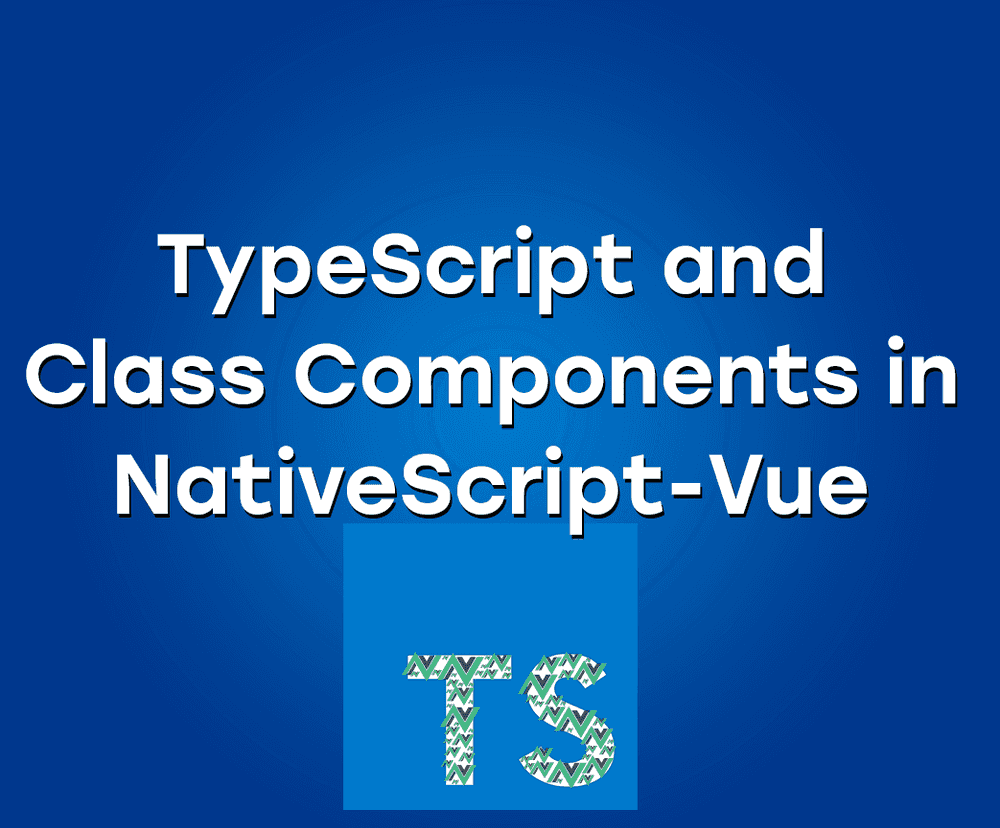TypeScript and Class Components in NativeScript-Vue
The time that we've all been waiting for has finally come. Ok, maybe the time that I've been waiting for... Big News NativeScript-Vue…
Take control of your career. Build JavaScript mobile apps.
The time that we've all been waiting for has finally come. Ok, maybe the time that I've been waiting for...
Big News
NativeScript-Vue finally got TypeScript support! Here is the pull request by Manuel Saelices that made it possible.
UPDATE:
This news is still news, but within the same month that we got yet another update: NativeScript-Vue is now officially supported. You can read this post, or you can just skip right to the new announcement.
CAUTION:
One word of caution: as of this moment, you cannot create a NativeScript-Vue project with TypeScript using the NativeScript-CLI. Hopefully this will be implemented soon. So this post still applies for those folks that want to use TypeScript in their NativeScript-Vue apps.
Today we'll take a look at how we can use the Vue CLI to generate a new NativeScript-Vue project with TypeScript, AND we're going to add just one more thing that doesn't come in the box: class components.
If you like videos instead, watch this one to get all the info about NativeScript-Vue with TypeScript and class components.
First, There is No NativeScript-Vue
There is now 😃, but with a caution. see the note above.
Before diving into the TypeScript options, here is just a quick intro to how NativeScript-Vue works. If you want to get to the TypeScript part ASAP, go to the next section.
There's no such thing as NativeScript-Vue! Surprised?
Here's what I mean. NativeScript-Vue is not a thing, or a tool, or a technology. NativeScript-Vue is a collection of technologies and tools that work together to give you the ability to run the VueJS UI framework on top of native mobile apps. It's a specific workflow.
To generate a new project, NativeScript-Vue leverages the Vue CLI and provides a template that the CLI can use to scaffold out a new NativeScript project.
To work NativeScript-Vue needs:
- ⚫ Vue CLI (2.x or higher)
- ⚫ The vue cli-init package
- ⚫ The nativescript-vue/vue-cli-template
- ⚫ All the latest NativeScript bits and pieces
Install the Vue CLI and the cli-init tool globally via npm
npm install -g @vue/cli @vue/cli-initUse the Vue CLI to generate a new NativeScript project using the cli-init tool and the nativescript-vue vue-cli-template.
vue init nativescript-vue/vue-cli-template <project-name>Boom! You're done!
I ALWAYS forget this, please don't: Make sure that when you run your app on the iOS or Android emulator or device, please, please, please remember to use the --bundle flag. Otherwise you'll be scratching your head and creating a bald spot, like me.
tns run ios --bundleNow, with TypeScript
Now that TypeScript support comes packaged into the the nativescript-vue/vue-cli-template, we can get TypeScript right out of the box without trying to put a square peg in a round hole later.
When you run the Vue CLI command as I've shown above, you get an interactive wizard that asks you some questions.
- Project name
- Project description
- Applicatio blah blah blahThe one you want. Scratch that. The one you NEED is:
- Select the programming language
- javascript
- typescript <- this one
- and a few more optionsThis will create a new NativeScript project, with the proper packages in the package.json file, a properly configured tsconfig.json, and here's the big one: a properly comfigured webpack.config.js file. There is also a types folder that has extra TypeScript declarations for the environment, Vue shims, and nativescript platform references.

The app folder has a main.ts file. Yes that's a .ts extension you see there.
And your single file Vue components have a code block that specifies TypeScript as the language. Notice the ts value for the lang attribute on the script tag.
<script lang="ts">
export default {
data() {
return {
msg: 'Hello World!'
}
}
}
</script>By the way, you can omit this lang attribute and just write plain JavaScript here if you want. This is useful for projects that are transitioning from JavaScript to TypeScript, for example.
Finally, with TypeScript AND Class Components
If you are coming from an Angular background, then you'll feel right at home with class-based components with decorators. This is the next logical step to take after switching to using TypeScript and a natural one for Angular devs.
Why use class components? Simple - the syntax is cleaner. Class properties are automatically data properties. No need for strange functional syntax returned by the data property, and you don't have to worry about this.
Step 1
Out of the box, the new nativescript-vue cli template creates function-based TypeScript components. If you want to get Class Components AND TypeScript, there are a few manual steps you need to perform. Hopefully these will be rolled into the template too at some point.
In your project's package.json file, add the following dependencies to support Vue class components and and decorators:
"dependencies": {
...
"vue-class-component": "^6.3.2",
"vue-property-decorator": "^7.3.0",
...
},Run npm install
Step 2
You can start using Class Components right away.
Create a single file component file, let's call it MyComp.vue and add this code:
<template>
<Label class="message" :text="msg" col="0" row="0"/>
</template>
<script lang="ts">
import { Component, Prop, Vue } from "vue-property-decorator";
@Component
export default class MyComp extends Vue {
@Prop() private msg: string;
}
</script>Notice instead of the default export being a function, here we're exporting a class. And instead of importing Vue from vue, we're importing it from vue-property-decorator.
Don't forget the @Component decorator on the class.
For more video tutorials about NativeScript, look at our courses on NativeScripting.com. If you're feeling adventurous, the new NativeScript Security Course is an advanced walk-through on making your NativeScript apps secure.
Let me know if you enjoyed this short tutorial on Twitter: @digitalix or comment here. And send me your NativeScript related questions that I can answer in video form. If I select your question to make a video answer, I'll send you swag - use the hashtag #iScriptNative.



